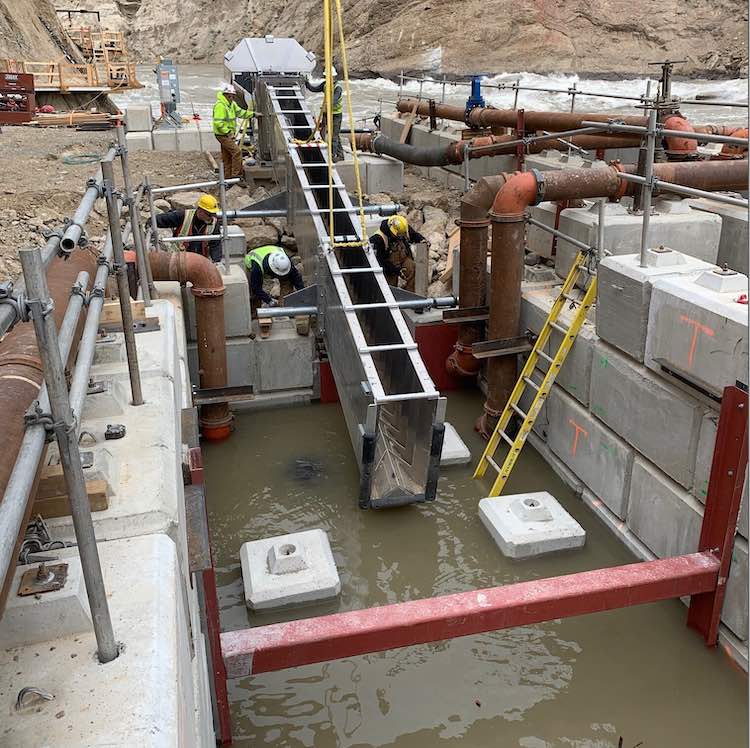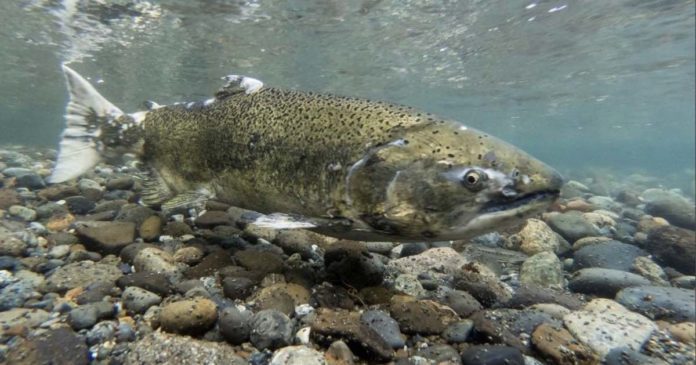The Big Bar slide on the Fraser River is thought to have occurred in the fall of 2018 however it was not discovered until June 2019. It is located roughly 64 kilometers north of Lillooet at an extremely remote location and is the single biggest impediment to salmon migrating to Upper Fraser River systems since the Hell’s Gate Slide a century ago. Big Bar impacts have been most severe on early runs of Upper Fraser River Chinook salmon, which have been under conservation watch since 2006, as well as Sockeye destined for many of the same up-river systems. These runs were hit particularly hard because they not only had to navigate the five meter falls created by the debris; their migration timing also coincides with the annual spring run-off in the Fraser watershed making passage over the blockage even more difficult. In 2019, despite desperate efforts to move delayed salmon past the obstruction by helicopter and later by truck, the returns on the spawning grounds from early migrating stocks was dismal.

Later runs fared much better once water levels dropped enough to allow passage through the boulder strewn blockage. Unfortunately the poor return of early run fish will affect escapements and fishing opportunities from the 2019 spawning cycle for years to come. This disaster has been given top priority status by the Federal and Provincial governments with assistance from and consultation with local First Nations. A detailed blockage removal plan has been put together for 2020 to achieve the goals as quickly as possible. Burnaby engineering firm Peter Kiewit will handle blockage removal along while Washington State Whoosh Innovations, developers of the Salmon Cannon fish transportation system, have been contracted for 2020 to speed and simplify salmon transport above the slide area,
Update: July 27 2020
- On July 17th the second phase of the Salmon Cannon installation began. This involves increasing transport capacity to six lanes of varying size to accommodate different sizes and species of salmon.

- Work in progress includes expanding the data collection capacity by radio tagging salmon so Fisheries can monitor their upstream progress to determine passage and survival rates beyond the Big Bar obstruction. Fish are being fitted with radio tags located in their stomachs or on their backs. To date 233 Chinook have been tagged and 62 have been recorded moving past the monitoring station located 40 km above the slide. These radio tags emit a signal that can be picked up by receiver arrays positioned along the Fraser River and in some of the larger tributary rivers. The plan is to expand this capacity.
- DNA analysis will identify high priority Chinook stocks and those salmon will be transported to the Vanderhoof hatchery to ensure there will be brood stock for systems with critically low returns.
- Upgrades are also being made to a hatchery facility at the Spruce City Wildlife Association in Prince George, and at the Quesnel River Research Facility.
- Completed work includes: The French Creek Bar salmon holding facility and the concrete fish ladder at the slide site.
- 45,000 Sockeye have been counted in the lower Fraser River and some have been observed near Lillooet where capture by seine is underway.
- On the negative side high flows in the river, which peaked at 6,000 cubic meters per second, delayed work by damaging some structures and depositing sediment in the fish ladder. Repairs have been made and the sediment removed. The high flows also delayed salmon progress upstream and anticipated arrival time at Big Bar.







One pathetic joke on the part of Fisheries and Ocean and Federal and Provincial politicians. It happens in the fall of 2018 and it takes six months to find it….Then foot dragging and indecision over a period of almost two years. It’s called ‘wild’ genetics and they are not getting to the upriver spawning beds. Bernadette Jordan should be turfed from office and along with her more than few supervisors at DFO.